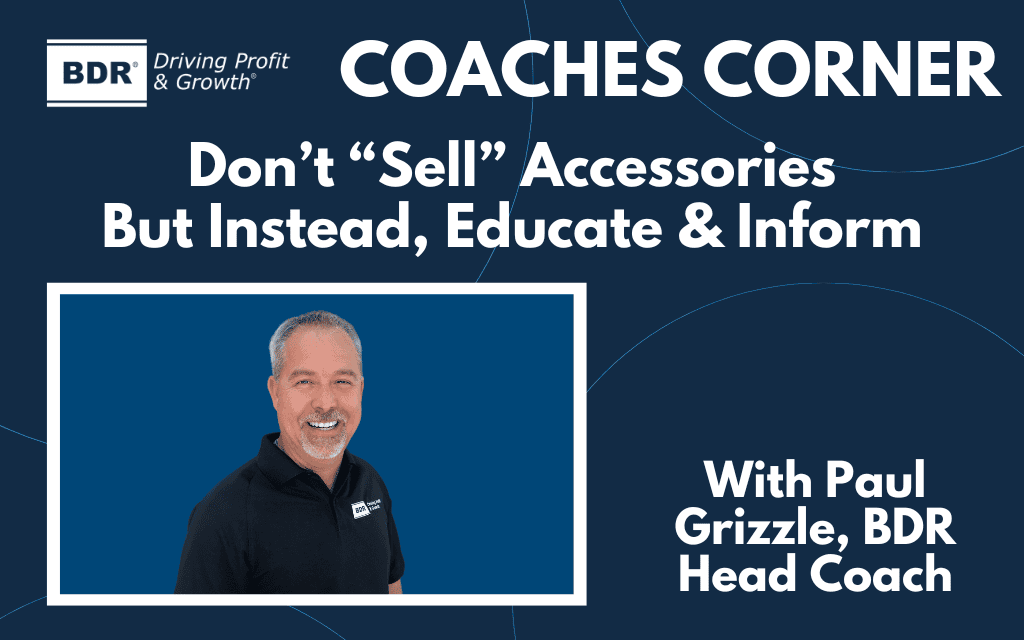Don’t “Sell” Accessories But Instead, Educate & Inform

PAUL GRIZZLE
BDR Head Coach
Accessories are a powerful tool for the company to grow gross profit dollars. Joseph Ortiz, BDR’s Client Relationship Coordinator, has created many accessory brochures for our clients–that’s the easy part. You print it and hand it to your co-workers—also easy! Then you tell your team, “Go sell some accessories. I expect one sold a day starting today.” Sound familiar?
You may have noticed that the coworker doesn’t end up selling anything or even offering one of the accessories. Here is the challenge: How do you successfully implement an accessory strategy so your entire team and clients win?
It all starts with you, the leader. Examining oneself takes great courage–it’s about the team, not ourselves, and understanding this strategy takes dedication to ongoing training. You must be tenacious each day in pursuing this goal. Let’s ask ourselves some questions:
- Are you informing, offering, and educating the team on the accessories you offer?
- Do you have a training outline with dates on the calendar to inform, offer, and educate the team?
- Is the entire team involved?
- Techs, coordinators, sales?
- Did the team provide feedback on the accessory selection?
- Do you have any of the accessories in your own home to show you believe in them?
Now let’s look at the logic behind this strategy, based on just one technician selling one $250 accessory per day:
1. For the Company
- Accessory revenue for the company is $250 a day x 22 days =$5,500
- $5,500 x 12 months = $66,000 additional revenue per year
- Average gross profit of 60% = $39,600 gross profit dollars, which drops to net profit
2. For the Coworker
- Spiff of $25 x 22 days x 12 months = $6600 for the year
- $6600 / 2000 hours = $3.30 per hour opportunity added to their hourly pay
Wahoo, right? You would think this logic would motivate the coworker and the company, but for many, it doesn’t.
How do we resolve this issue? Recently, I attended leadership training with my wife and learned that one must develop one’s emotional why. Defining you and your team’s emotional why is the first step:
- It will motivate you to get out of bed and put forth your best effort.
- It will be the basis of your mission and goal.
- It possesses the ability to empower you.
Here are some examples of a coworker’s emotional why:
- Buy a boat.
- Take a vacation.
- Pay for college or send the kids to a school of your choice.
- Get out of debt.
If you can connect the emotional why to the results of informing, educating, and offering, you will impact your accessory sales.
For example, a team member would like to pay off debt. We can help that team member develop a plan (connecting their emotional why to the process). If one accessory per day were purchased, earning a minimum $25 spiff, they would have $550 per month to pay down the debt. The overall result is reducing their annual debt by $6,600! Wahoo!
It is the leader’s responsibility to uncover each coworker’s emotional why. And yes, this means you must learn about your coworkers. Zig Ziglar said, “You will get all you want in life if you help enough other people get what they want.”
My challenge to you is to find your coworkers’ emotional why, then teach and mentor them how to inform, offer, and educate using your accessory brochure. In the long run, your clients will appreciate the efforts you have made by investing in your team to deliver a world-class customer experience.
Wahoo!
About the Author
Paul Grizzle‘s HVAC career spans over 24 years of total industry experience, with 15 years as a successful business owner, six years in a leadership role within the Air Conditioned Contractors of America (ACCA) organization, and two years working with BDR as a client in the Profit Coach program. After joining the Profit Coach program, he leveraged to refine his business processes, install HVAC-specific financial accounting and performance analysis, and then built a BDR-caliber business plan for his company. Within the year, Paul sold his business to a respected local HVAC business owner, and it remains a Profit Coach client. Paul now brings his vast knowledge, experience, and success to BDR’s clientele as a Profit Coach.

